After viewing The Hobbit: Desolation of Smaug yesterday, I immediately watched The Hobbit: An Unexpected Journey at home, my first time viewing the movie since it was in theaters last year. As their narratives are so intertwined, I decided to review both films as well as weigh in on the entire idea of doing The Hobbit as a trilogy.
The Hobbit: An Unexpected Journey
Last year’s The Hobbit: An Unexpected Journey unexpectedly re-ignited my dormant Lord of the Rings fandom. As I am one given to manic bouts of obsessive binge-viewing/researching, after seeing Unexpected Journey I practically escaped to my own hobbit hole in the ground, spending the entirety of upwards of a week marathon viewing all three Lord of the Rings films. We’re talking the extended director’s cuts here, as in the ones that have as much as 50 minutes of additional footage. But that was not enough to satisfy my Tolkien-needs. No, I also had to watch every single special feature on the DVDs, which I had somehow never viewed before. Plus, at the risk of officially over-sharing because this is where it gets really sad, after watching the extended editions proper I re-watched them with the DVD commentaries from director Peter Jackson and co-screenwriters Fran Walsh and Philippa Boyens.
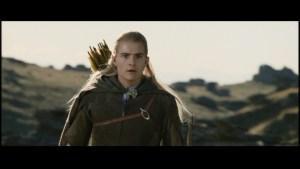
Fun aside: They, too, think Legolas’ odd “they run as if the very whips of their masters were behind them” line from the beginning of Two Towers doesn’t quite work.
While my experience is inarguably on the extreme side of things, I know from anecdotal evidence that it is also not entirely unique. An Unexpected Journey often feels more like an advertisement for the original trilogy than it a proper film of its merit. As the first film in a new prequel trilogy, it was tasked with the burden of re-establishing the cinematic universe of Middle Earth and bridging the gap between the original films and the new. As a result, it begins with a lengthy voice-over and extended cameo from Ian Holm’s Bilbo Baggins, who we see writing his book and preparing for his birthday party – you know, the birthday party he has at the beginning of Fellowship of the Ring. Once Elijah Wood shows up to say a quick hello before going off to surprise Gandalf (Ian McKellan) on the road into the Shire – you know, like we see in Frodo’s first scene in Fellowship of the Ring – you’d be forgiven for wanting to jump into the screen and merely follow Frodo through the door as he departs for the beginning of his own amazing adventure.
But, alas, we were stuck with a meandering tale of a young Bilbo (Martin Freeman…doing his basic solid Martin Freeman performance) and bunch of interchangeable dwarfs running from things, but not before they’ve had a good meal, cleaned the dishes, and looked off into the distance during a solemn sing-a-long. Gimli, the dwarf from Lord of the Rings, was awesome and hilarious. These guys? Neither particularly awesome nor annoying but merely present, save the thick slab of smoldering man-meat that continues to be Richard Armitage’s Thorin.
However, this was largely unavoidable based upon the source material, the 300-page children’s book The Hobbit, and Peter Jackson & Co.’s extremely curious decision to split it up into three films instead of two. The Hobbit is a novel in which the hapless protagonists pretty much keep getting captured and almost killed, saved on almost every occasion by either Bilbo or Gandalf, the latter of whom disappears for stretches at a time seemingly just so Tolkien could bring him back to save the day. It culminates in a genuinely awesome confrontation with a dragon and a subsequent messy land claim squirmish between various factions who ultimately have to combine their forces against a common enemy (aka The Battle of the Five Armies). The destination of this particular hero’s quest is to fell a dragon for the purpose of reclaiming a homeland and bounty of gold. Those are solid if basic story ingredients; they’re just nowhere near as compelling as Lord of the Ring’s heightened tale of battling the most evil thing in all of creation in order to save the world. Gee, which ones feels more important.
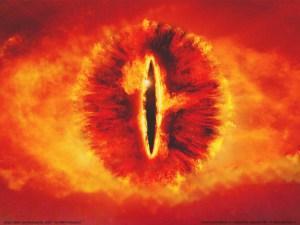
Smaug is but a potential ally to the ultimate evil, Sauron, who we know as the big giant red eye in the sky.
So, The Hobbit is a story which is comparatively lacking in character, narrative stakes, drama, and action. It’s a far lighter story pitched more to children, thus a more low-brow humorous set of villains like the three trolls. However, there is enough there to make a perfectly enjoyable if inferior couple of movies, but three of them? For a 300 page book? This is where narrative license comes into play. After having lovingly brought Tolkien’s creation to life in the Lord of the Rings trilogy, Peter Jackson, Fran Walsh, and Philippa Boyens are arguably now the world’s leading experts on Tolkien (except for maybe Stephen Colbert). Their decision to turn this into a trilogy likely comes from a pure place of passion for the material and intention to take more risks this time around. They have drawn upon Tolkien’s infamous Appendices which describe the history of Middle Earth to integrate further exploration of Gandalf’s frequent extended absences from the traveling party as well as raise stakes of the story. They have also elaborated on some things and just flat out created entirely unique characters and scenes of their own.

Tolkien tried to re-write The Hobbit in 1960 to fall more in line with the tone of Lord of the Rings until his publisher made him stop. Jackson & Co. are largely doing that for him now.
Yet Jackson & Co. seemed to have lost their mojo through the opening hours of An Unexpected Journey, which while not horrible is rather nondescript and unquestionably padded with needless exposition and needed-to-kill-some-screen-time action sequences (like the fighting mountains). They were largely hindered by just how many familiar Lord of the Rings story elements show up. It is difficult for our new characters to establish themselves when they are preceded by Frodo and the original Bilbo and encounter those with which we have far more history like Elrond, Sarumon, and Galadriel in a location like Rivendell with the signature Howard Shore Lord of the Rings orchestral score in the background. It might actually work better if you’ve never seen Lord of the Rings, and these are just random god-like entities who show up for a bit and then are gone. However, the film’s lack of explanation for these people indicates they assume its audience has seen Lord of the Rings
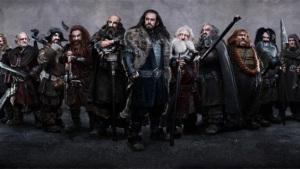
You’d still be hard-pressed to even know the names of any of the dwarves except for Thorin and Balin (the old one with gray hair who gets the back-story speeches). Beyond that, you could maybe describe some of them (e.g., the one with the unibrow, the one with the funny hair and mustache, the brothers who don’t actually have beards).
Then Gollum shows up around the 2 hour mark, and regardless of whether or not you’ve seen Lord of the Rings An Unexpected Journey takes on a whole new life. Andy Serkis’ motion-captured performance again presents Gollum as an oddly menacing but pitiable creature. His riddles in the dark with an increasingly clever Bilbo (Martin Freeman) crackles with an edge-of-your-seat energy, partially because you might be straining to understand all of Gollum’s garbled lines but also because the tension is ratcheted up so effectively you fear for Bilbo’s safety despite knowing he clearly survives the encounter.
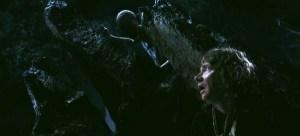
From that point forward, An Unexpected Journey barrels forward with enthralling action, going out on a high note that is only slightly undercut by the honest question that can pretty much unmake both The Hobbit and all three Lord of the Rings: if Gandalf can enlist the aid of the eagles to fly them from danger why on Middle Earth can’t the eagles just fly them all the way to their destination? There is an in-universe, ultra-geeky Tolkien-riffic explanation involving the society of the eagles (though the films never actually give that explanation), but the real answer is because if the eagles did that then there’d be no story.
The Hobbit: Desolation of Smaug
An Unexpected Journey mostly failed to completely justify its own existence, beyond mere Lord of the Rings nostalgia, before pulling it all together in its final third and going out on a high note that whets your appetite to finally see that dragon they kept talking about. Now, it is a year later and The Hobbit: Desolation of Smaug is here, opening to fewer box office dollars than Unexpected Journey but more enthusiastic reviews. This is supposed to be the bigger and better sequel that is almost on part with the original Lord of the Rings films.
Unfortunately, with Desolation of Smaug Peter Jackson & Co. again struggle to know how to start their story but again make-up for it with an astounding final third which ends (as opposed to concluding) so abruptly the audience at the screening I attended seemed to unanimously respond with incredulous laughter, one person shouting, “Oh, come on!” That’s actually kind of good. That means we all wanted to see how this was going to end, even if we already read the book/appendices and have guessed where this headed.
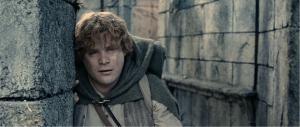
There is no great ending speech from a character tying everything together in Desolation of Smaug as there was in Unexpected Journey and The Two Towers
But to get to that point you have to first start at the beginning. Desolation of Smaug attempts in its very first scene to shift An Unexpected Journey’s focus on Bilbo to a focus on Thorin for the sequel, as we open with Gandalf and Thorin’s first meeting a year prior to the events of An Unexpected Journey. In this short scene, we discover that the plan to reclaim The Lonely Mountain is pretty much entirely Gandalf’s idea, and we witness how low Thorin had fallen, dining alone at The Prancing Pony with mercenaries closing on him from both sides. We then pick up the story sometime after the events of An Unexpected Journey, although if you need a refresher on where the story left our characters you will be a bit lost at first as they mostly proceed as if you remember everything about Unexpected Journey. The gist is that Azog the Defiler (Manu Bennett) and his pack of arcs are still hunting Thorin and the dwarves. Rather quickly, both Azog and Gandalf vacate this plot line to instead be inserted into the parallel story involving the rise of the necromancer, who commands Azog in non-corporeal form from a ruined fortress and who Gandalf and Radagast (Sylvester McCoy, toned down and more enjoyable this time around) suspects might actually be Sauron.
The dwarves get lost, captured, almost die, Bilbo saves them, rinse and repeat. This formula encompasses both an encounter with some nasty looking giant spiders as well as an extended stay with the wood elves, whose king is Captain Douchebag (okay, he’s actually Thranduil played by Lee Pace from Pushing Daisies, but my nickname is an accurate assessment of his characterization) but whose son is Legolas (Orlando Bloom).
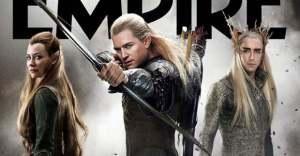
Left to Right: Lily, Bloom, and Pace as Tauriel, Legolas, and Thranduil
Although not actually in the novel The Hobbit, the inclusion of Legolas here is enjoyable though not entirely necessary. This slightly younger, more naïve Legolas continues to be a delight to see in action scenes. Less successful might be his shoehorned love triangle with a completely unique character to the films, Tauriel (Evangeline Lily), a Lady Sif from Thor-like female warrior who is captain of the guard. Complicating their mutual affection is Kili (Aidan Turner), one of Thorin’s dwarves who forms an interesting connection with Tauriel even from behind the bars of a wood elf prison cell.
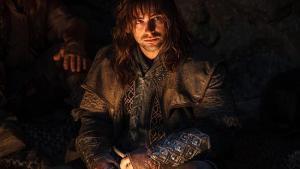
Aidan Turner as Kili in Desolation of Smaug
That they would go in this direction seems to further justify why they poached the heartthrob-like Aidan Turner from the UK TV show Being Human for this trilogy. However, it does feel tacked on, the type of material inserted to pad running time and provide romance to a source material which has none. In fact, Lily is such a scene-stealer and general bad-ass as Tauriel that a love triangle or romance of any kind beyond mere hinting seems unnecessary to making her a captivating screen presence.
Things pick up with the story during an escape scene involving the dwarves in barrels, an increasingly large number of orcs, preternaturally graceful and badass elves in pursuit, and a raging river. This sequence is an astounding piece of action, with several crowd-pleasing moments.
And then we meet Bard the Boatsman (Luke Evans) and Stephen Fry shows up to suck up screen time as an extraneous semi-villain, leader of a drab placed named Laketown, and….oh, please, can we just get to the dragon already? Thankfully, that does happen, as it would be quite difficult to do The Desolation of Smaug without Smaug in it. Without a doubt, Smaug is the most perfectly realized dragon yet captured on film, with a frame that is as astounding to the viewer as it is to Bilbo. While his voice has clearly been digitally enhanced, Benedict Cumberbatch signature deep voice is instantly recognizable, and while he’s not Scarlett Johansson in Her-good his sly and foreboding Smaug is the best aspect of this movie.
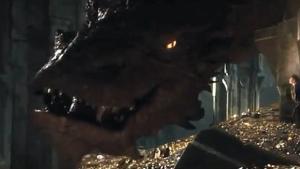
Smaug is this movie’s Gollum, with Bilbo’s encounter with Smaug granted almost as faithful a treatment as his riddles with Gollum.
The other aspects of the narrative are more difficult to assess as they, more so than in The Two Towers, are all set-up with no pay-off. Everything we learn about Bard and Laketown and Thranduil and the Wood Elves will likely pay off in the next film. Evans does make for an interesting addition as Bard, although he and Armitage together on the same screen is perhaps more smoldering brooding than the film can handle. More progress is made with Gandalf’s investigation of the necromancer, which does build to an genuinely awesome action sequence. However, it, too, is left as mostly set-up for a pay-off.
The performances from the actors remain reliable, with the returning actors good to great (Armitage, Freeman, McKellan, Bloom, Turner) and some of the new truly standing out (Lily, Evans). Unfortunately for a film called The Hobbit, Freeman actually gets a little lost in the shuffle quite frequently, Bilbo overshadowed by the likes of Legolas and others before getting his showcase with Smaug. However, Freeman’s one real moment in the film of a hint of the ring’s corruptive influence is played beautifully in an extended, speechless reaction shot. The special effects are cutting edge, with seamless transition between practical footage and effects and completely computer-generated. Smaug, in particular, is astounding. The 3D adds depth, an errant bee being the most notable exception of throwing something directly at the screen since it’s 3D. If you see it in 3D HFR, know that the experimental high frame speed continues to present unexpected consequences, such as inducing nausea in audiences as well as actually drawing unwanted focus to the artifice of the sets and special effects. I saw it in 3D HFR and adjusted rather quickly.
THE BOTTOM LINE:
Someone recently argued that these Hobbit films are not real movies but instead exploitation films for Tolkien nuts and enthusiasts of the Lord of the Rings trilogy. Our potential enjoyment of them, the argument went, is “more of an involuntary reaction to exposure to certain elements, not the summation of a film.” There is some truth to that argument. However, neither An Unexpected Journey nor The Desolation of Smaug make for completley unenjoyable viewing experiences. Both films suffer from cold starts but benefit from hot finishes. The Desolation of Smaug is the better paced and more thrilling of the two, though by comparison An Unexpected Journey seemed more adept at maintaining Bilbo’s place in the narrative and providing him an emotional throughline. In both cases, there is more waiting for the film to finally start clicking than there was in the Lord of the Rings trilogy, but it does eventually happen. Smaug clicks earlier and is generally more astounding. Tolkien purists will have far more to complain about with Smaug than any prior Lord of the Rings/Hobbit film, as Jackson & Co. have put their own stamp on the story with entirely new characters, backgrounds for existing characters, plot points, etc. However, once you get to that dragon…behold his splendor, just don’t expect any closure because you’ll have to wait a year until the final film of the trilogy.
A SCENE FROM DESOLATION OF SMAUG
What did you think? Like it? Hate it? Let us know in the comments section.
Second Opinions
- An Unexpectedly Inconsistent Journey [The Hobbit: An Unexpected Journey Review] (trickyandthecynic.wordpress.com)
- The Hobbit: The Desolation of Smaug (hkauteur.wordpress.com)
- Second Breakfast: The Desolation of Smaug (roosterillusionreviews.com)

